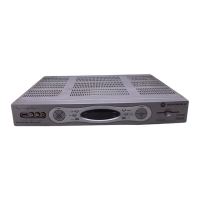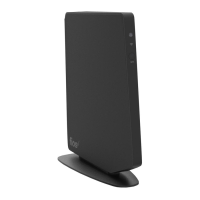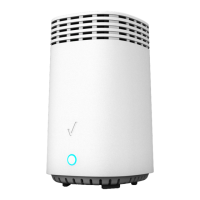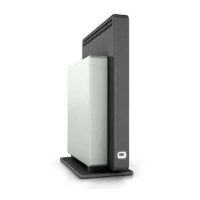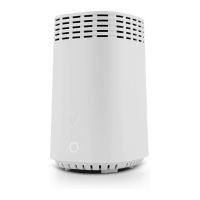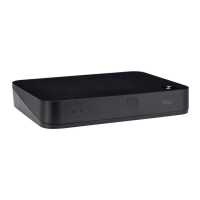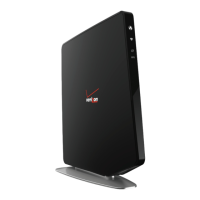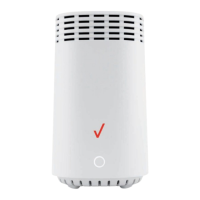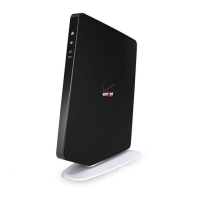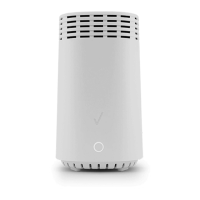







Do you have a question about the Verizon FiOS and is the answer not in the manual?
Lists the items included in the Fios Router package.
Details the software and hardware needed for the Fios Router.
Describes the capabilities and standards supported by the Fios Router.
Explains front/rear panels, ports, and mounting instructions.
Step-by-step guide for installing and configuring the Fios Router.
Instructions for using a Fios Extender to improve Wi-Fi signal range.
Guides for configuring network settings on Windows and Mac OS.
Describes the router dashboard and status information.
Explains Wi-Fi standards, speeds, and security features of the Fios Router.
How to view the status of the router's Wi-Fi network (ON/OFF, SSID, Password).
Configuration of Wi-Fi radio, SSID, and security for 2.4/5 GHz bands.
Customizing advanced Wi-Fi security like SSID broadcast and MAC authentication.
Adjusting Wi-Fi channel settings for optimal performance on 2.4/5 GHz bands.
Enabling and configuring a separate Wi-Fi network for guests.
How to view and manage network connections and devices on the router.
Common network parameters like blocking devices, website blocking, and port forwarding.
Viewing and managing different types of network connections (Ethernet, Wi-Fi, Coax).
Viewing and configuring properties of the local network connection.
Setting up the router as a Wi-Fi access point for 2.4/5 GHz networks.
Viewing and configuring properties of the Ethernet LAN connection.
Viewing and configuring broadband connection properties via Ethernet or Coax.
Creating access policies, blocking websites, and keywords based on schedules.
Viewing and managing created parental control rules and schedules.
Setting firewall levels, blocking traffic, and configuring IPv4/IPv6 security.
Blocking or allowing specific computers/services from accessing the internet.
Exposing network services to the internet via controlled port forwarding.
Dynamically opening firewall ports based on outbound traffic.
Exposing a single device fully to the internet for special purposes.
Making internal hosts with private IPs appear as public IPs on the internet.
Allowing incoming packets to specific ports via IPv6 pinholes.
Overview of accessing Utilities, Network, Date/Time, DNS, Monitoring, System settings.
Diagnostics, save/restore, reboot, MAC cloning, ARP/NDP tables, user management.
Network objects, UPnP, port forwarding, IPv6, routing, port configurations.
Setting time zone, auto-updates, and firewall rule activation schedules.
Managing Dynamic DNS and DNS server configurations.
Viewing system logs, connection/traffic monitoring, and bandwidth usage.
Configuring hostname, domain, refresh, password prompts, and remote administration.
Solutions for connection failures, locked-out access, and timeout errors.
Answers to common user questions on ports, Wi-Fi, passwords, and connectivity.
Details on model, standards, IP, MoCA, speed, and firewall certification.
Description of LED indicators on the front and rear panels of the router.
Operating/storage temperature and humidity specifications for the router.
FCC compliance for Class B equipment and RF exposure limits.
Safety precautions for cable distribution systems and grounding.
Network Equipment Building System statement for external SPD usage.
Information on open source software licenses and source code availability.
Lists the items included in the Fios Router package.
Details the software and hardware needed for the Fios Router.
Describes the capabilities and standards supported by the Fios Router.
Explains front/rear panels, ports, and mounting instructions.
Step-by-step guide for installing and configuring the Fios Router.
Instructions for using a Fios Extender to improve Wi-Fi signal range.
Guides for configuring network settings on Windows and Mac OS.
Describes the router dashboard and status information.
Explains Wi-Fi standards, speeds, and security features of the Fios Router.
How to view the status of the router's Wi-Fi network (ON/OFF, SSID, Password).
Configuration of Wi-Fi radio, SSID, and security for 2.4/5 GHz bands.
Customizing advanced Wi-Fi security like SSID broadcast and MAC authentication.
Adjusting Wi-Fi channel settings for optimal performance on 2.4/5 GHz bands.
Enabling and configuring a separate Wi-Fi network for guests.
How to view and manage network connections and devices on the router.
Common network parameters like blocking devices, website blocking, and port forwarding.
Viewing and managing different types of network connections (Ethernet, Wi-Fi, Coax).
Viewing and configuring properties of the local network connection.
Setting up the router as a Wi-Fi access point for 2.4/5 GHz networks.
Viewing and configuring properties of the Ethernet LAN connection.
Viewing and configuring broadband connection properties via Ethernet or Coax.
Creating access policies, blocking websites, and keywords based on schedules.
Viewing and managing created parental control rules and schedules.
Setting firewall levels, blocking traffic, and configuring IPv4/IPv6 security.
Blocking or allowing specific computers/services from accessing the internet.
Exposing network services to the internet via controlled port forwarding.
Dynamically opening firewall ports based on outbound traffic.
Exposing a single device fully to the internet for special purposes.
Making internal hosts with private IPs appear as public IPs on the internet.
Allowing incoming packets to specific ports via IPv6 pinholes.
Overview of accessing Utilities, Network, Date/Time, DNS, Monitoring, System settings.
Diagnostics, save/restore, reboot, MAC cloning, ARP/NDP tables, user management.
Network objects, UPnP, port forwarding, IPv6, routing, port configurations.
Setting time zone, auto-updates, and firewall rule activation schedules.
Managing Dynamic DNS and DNS server configurations.
Viewing system logs, connection/traffic monitoring, and bandwidth usage.
Configuring hostname, domain, refresh, password prompts, and remote administration.
Solutions for connection failures, locked-out access, and timeout errors.
Answers to common user questions on ports, Wi-Fi, passwords, and connectivity.
Details on model, standards, IP, MoCA, speed, and firewall certification.
Description of LED indicators on the front and rear panels of the router.
Operating/storage temperature and humidity specifications for the router.
FCC compliance for Class B equipment and RF exposure limits.
Safety precautions for cable distribution systems and grounding.
Network Equipment Building System statement for external SPD usage.
Information on open source software licenses and source code availability.
| Brand | Verizon |
|---|---|
| Model | G3100 |
| Wireless Standards | 802.11a/b/g/n/ac/ax |
| Parental Controls | Yes |
| Guest Network | Yes |
| Wireless Frequency Bands | 2.4 GHz and 5 GHz |
| Ethernet Ports | 4 Gigabit Ethernet |
| USB Ports | 1 x USB 3.0 |
| Security Features | WPA2, WPA3 |

